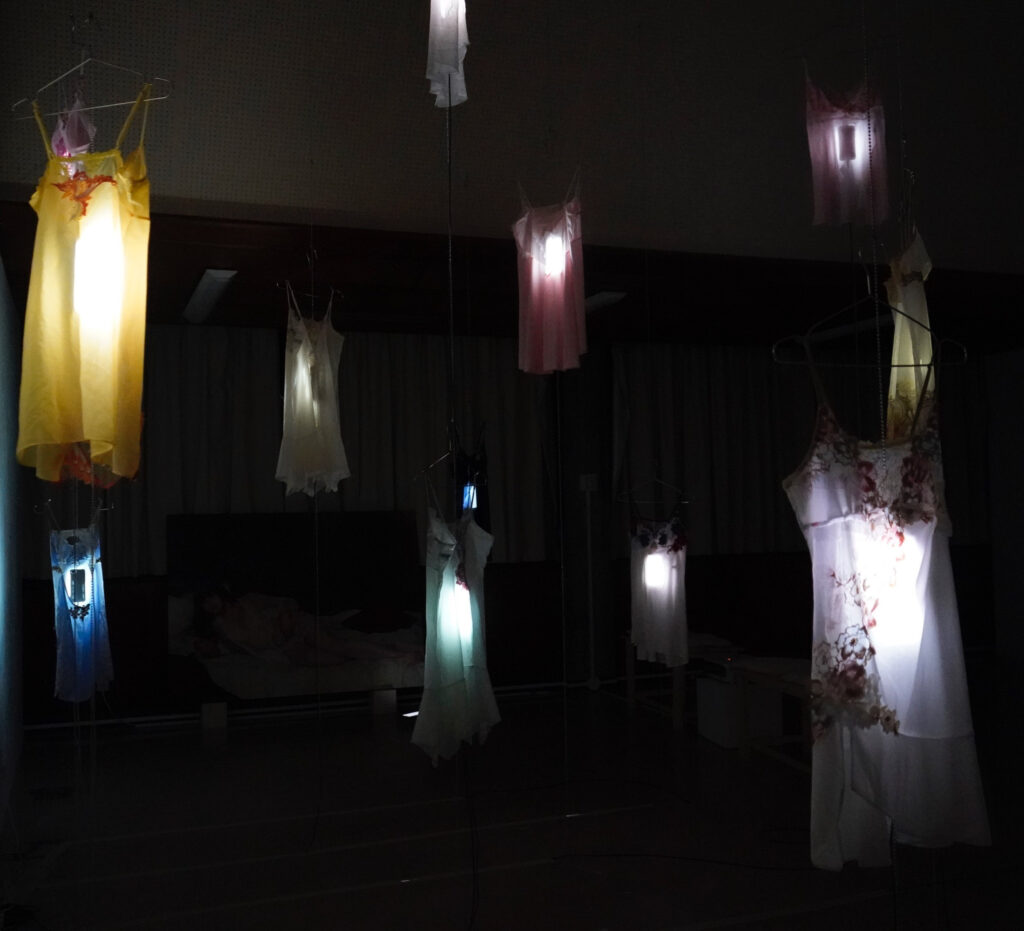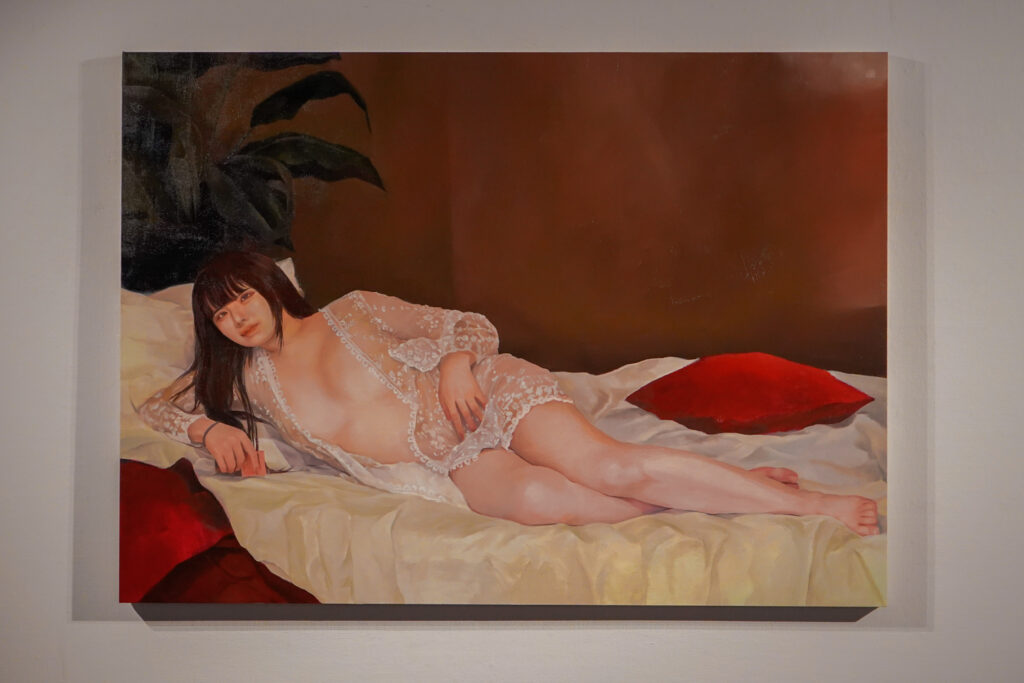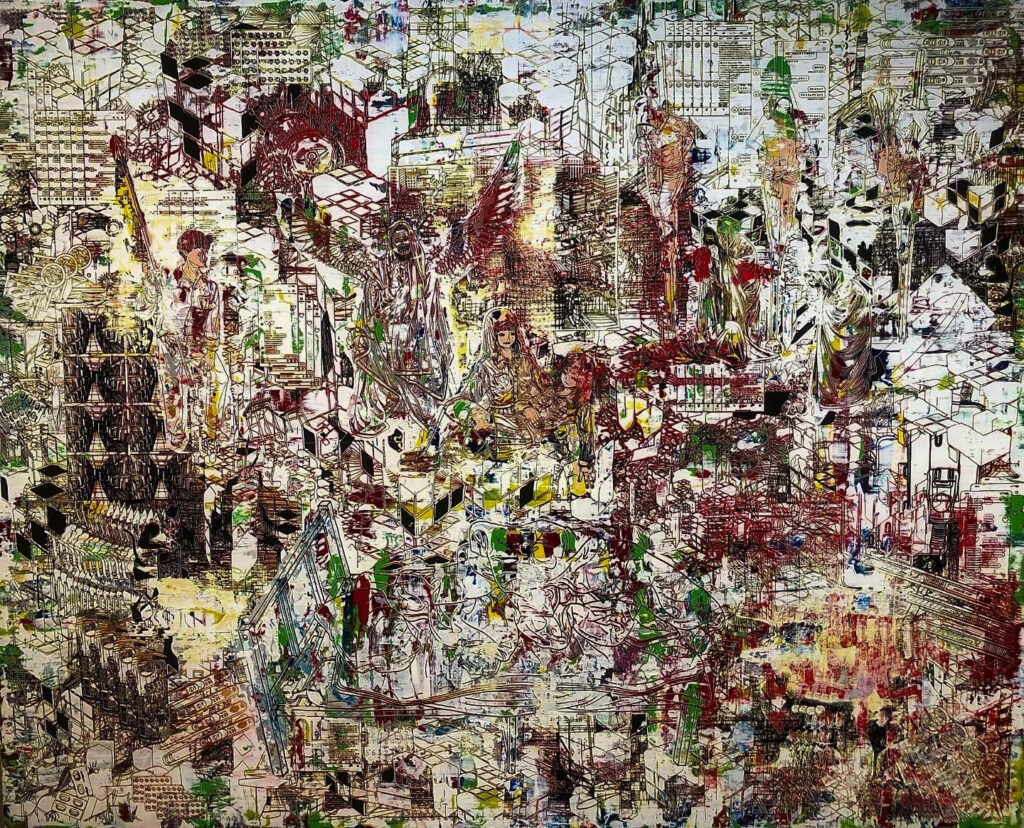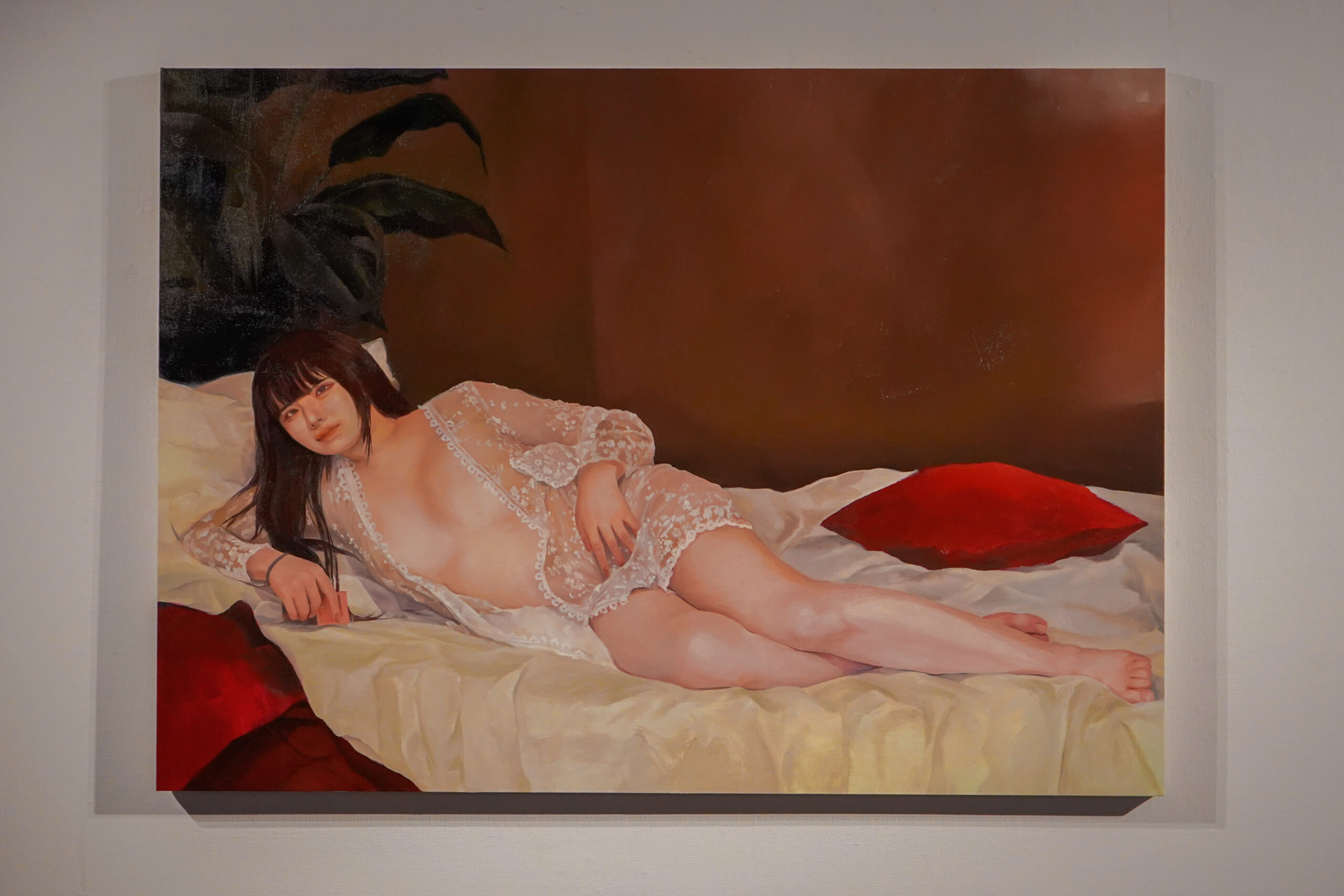A group exhibition by Asano Miyabi, Okoshi Madoka, and Kano Maashu
aaploit is pleased to present Asymmetrical Gaze (非対称な視線), a three-artist exhibition featuring Asano Miyabi, Okoshi Madoka, and Kano Maashu, running from October 31 through November 16, 2025. This critical group exhibition brings together three artists in their twenties who interrogate the asymmetrical power dynamics embedded within acts of seeing—each approaching this theme through distinct media and conceptual frameworks. From art history’s traditional structure of “male painter/female subject” to contemporary power relations generated through social media and nightlife economies, the exhibition will invite visitors to reconsider multiple layers of asymmetry in visual culture.
The Power of the Gaze
“Gaze” in this exhibition extends beyond a simple direction of sight—it refers to the dynamics between viewer and viewed, explored throughout philosophy and art history.¹ Just as social visibility determines what can be recognized, the gaze constructs reality itself. Its asymmetry generates prejudice and control. The exhibition asks: Are we, as viewers, truly in a safe position?
Jobs that the state condemns as “inherently unhealthy.”² People whom a certain young man dismissed as those who “don’t need to exist.”³ Our society contains domains subjected to willful blindness and branded with prejudicial labels. Asymmetrical Gaze will challenge the very act of consuming social taboos through curiosity, making visible the power relations potentially embedded within that curiosity, and reconsidering our position as viewers and speakers.
Curatorial Vision: Three Perspectives on Visual Power
The exhibition will present three distinct yet interconnected approaches to visual asymmetry. Visitors will encounter works that make visible how seeing operates as a form of power—whether through art historical traditions, digital interfaces, or contemporary image-making processes. Each artist brings a rigorous critical methodology to this examination, transforming the gallery space into a site where viewers become conscious of their own positions within networks of looking and being looked at.
The three practices converge on a crucial question: When we look, what systems of power are we participating in? The exhibition will not offer easy answers but will instead create conditions for viewers to recognize their own implication in structures of visual power. This curatorial approach extends beyond thematic arrangement; it informs the very spatial structure of the exhibition, where acts of looking themselves become material.
The Artists and Their Approaches
Asano Miyabi: Body, Labor, and Art Historical Critique
Asano Miyabi works through installation and painting to connect art history with contemporary labor systems. Visitors will encounter camisoles suspended from the ceiling, their interiors illuminated by smartphone screens displaying messages of gratitude and analysis directed toward clients. Through these dual veils—undergarments and liquid crystal displays—the commodification of emotion and the management of selfhood become materially present.
The exhibition will also present nude paintings that critically engage with Western art history’s hypocritical practice of using sex workers as models while purifying their images into “sublime art.” Through what Asano describes as critical “mischief,” these works pull historical contradictions into contemporary view. The artist has conducted interviews with sex workers and received material contributions including the camisoles used in her installations.


The composition of Venus of Ikebukuro deliberately mirrors Titian’s Venus of Urbino, but the model here is a contemporary sex worker living in modern Tokyo. This connection reminds us that many masterpiece models throughout art history were sex workers. Different countries, different eras—yet these women share common ground.
Kano Maashu: Digital Icons and Contemporary Devotion
Kano Maashu creates works based solely on social media information, painting contemporary “devotion to young women” in Kabukicho, where women sacrifice themselves for their host club favorites. The artist layers these figures with religious narratives of self-sacrifice, revealing how hierarchies centered on “favorites” (oshi) function as invisible power structures. The worshipped hosts of the night world emerge as icons constructed from fragmented information.
Within this structure, visitors will be prompted to ask: Are we truly seeing these women’s realities? The exhibition will present works that acknowledge how system collapse has deepened women’s poverty while middle-aged men’s loneliness creates new grounds for exploitation.⁴

Kano’s multilayered production process involves applying base layers to wooden panels, overlaying silkscreen prints, painting with acrylics, applying silkscreen again, and then sanding. The resulting “misaligned lines” physically visualize the cognitive distortions created when reality and online information are superimposed.
Okoshi Madoka: iPhone as Mediator of Sight
Okoshi Madoka explores the boundaries between physical and digital reality through the iPhone as mediating device. The smartphone—ubiquitous in our hands—functions as a constantly accessible portal to the digital world, and as an “eye.”
In Invisible view, the same image will be presented across three layers—large-format print, photographic paper, and smartphone screen—inviting visitors to re-examine the positional relationships between physical and digital through their fingertips and screens. The gaps and gradations between physical and digital spaces will make perceptible the deviations in vision and perception.
Okoshi’s works transcend technological visualization to make conscious the asymmetries and power relations of vision mediated through the everyday device of the smartphone. While Asano addresses body and emotion, and Kano depicts contemporary icons, Okoshi interrogates the very nature of contemporary visual experience through screens.
Spatial Experience and Viewer Position
The exhibition will transform the gallery into a space where viewing itself becomes subject to examination. As visitors move through the installation of suspended camisoles, encounter layered paintings and prints, and interact with screen-based works, they will find themselves simultaneously occupying positions as viewers and viewed.
This dual positioning is not accidental but central to the exhibition’s structure. The works collectively create an environment where simple observation becomes impossible—where the act of looking reveals its own embedded assumptions and power dynamics.
Cultural and Critical Context
Asymmetrical Gaze emerges from a crucial moment in Japanese contemporary art where young artists are rigorously examining how visual culture participates in social power structures. The concept of “gaze” employed here draws from discourse developed through Laura Mulvey, Jacques Lacan, and subsequent developments in art history, film theory, and feminist criticism.¹
The exhibition addresses specifically Japanese contexts—from the state’s classification of sex work as “inherently unhealthy”² to the economics of host club culture⁴—while connecting these local realities to broader questions about visual power that resonate internationally. This dual positioning makes the exhibition particularly significant: it offers international audiences insight into specific Japanese social dynamics while addressing universal questions about how we see and are seen.
The three artists represent a generation that has grown up with digitally mediated vision as fundamental reality. Their works collectively suggest that understanding contemporary visual power requires examining multiple registers simultaneously: art historical traditions, economic structures, digital interfaces, and material processes.
Why These Three Voices Together
The curatorial decision to present these three practices together creates a multidimensional examination of visual asymmetry. Asano’s investigation of body and emotion, Kano’s exploration of digital iconography, and Okoshi’s interrogation of screen-mediated vision form a constellation of approaches that collectively reveal how pervasive and complex visual power has become.
Visitors will discover how these different methodologies—installation, mixed media painting, and screen-based work—each reveal different aspects of the same fundamental question: How do acts of seeing construct, maintain, and potentially transform power relations?
The exhibition anticipates that viewers will leave with heightened awareness of their own positions within networks of looking. This consciousness is not a conclusion but a beginning—the first step toward an ethics of seeing.
Artist Biographies
Asano Miyabi
Asano Miyabi completed her MFA at Aichi University of the Arts Graduate School of Fine Arts. She creates paintings and installations that critically intervene in the tradition of nude painting in Western art history. Through interviews with sex workers and dialogic production processes, her practice works to overturn art history’s power structure of “male painter/female subject.”
Born 2000 in Aichi Prefecture
Education:
- 2023: BA, Oil Painting, Aichi University of the Arts
- 2025: MFA, Oil Painting and Printmaking, Aichi University of the Arts
Selected Exhibitions:
- 2025: “Annual Young Adult,” New Ginzado, Gifu
- 2024: “Ura Manga Museum,” Vinyl Tape, Kyoto; “Seiryu 2024,” Gallery Sai, Nagoya; “CROSS OVER Vol.45,” Senso Art Gallery Cafe, Johor Bahru, Malaysia
- 2023: “Meta Vision,” YEBISU ART LABO, Nagoya; “Al Hamra,” Nagoya City Archives, Nagoya
Okoshi Madoka
Okoshi Madoka is currently a doctoral candidate in Social Informatics at Nagoya University Graduate School of Informatics. She creates media art works that meta-critically structure critical practice itself, analyzing and transforming into artworks the complicit relationship between the exhibition as institution and the viewer.
For more information: https://aaploit.com/artist/madoka-okoshi/
Kano Maashu
Kano Maashu is currently an MFA candidate in Painting at Tohoku University of Art and Design Graduate School. She presents mixed media works through silkscreen employing lacquer techniques. Her works, which use reproduction technology while completing as unique pieces, metaphorically suggest contemporary anonymity while depicting invisible relationships within contemporary cities.
Born 2001 in Miyagi Prefecture
Education:
- 2024: BA, Printmaking, Tohoku University of Art and Design
- Currently enrolled in MFA program, Painting, Tohoku University of Art and Design
Selected Exhibitions:
- 2025: “Xiao Zui Ri, Bu Huo,” SARP Sendai Artist Run Place, Sendai; “Teato: Realities Spun from Tohoku,” Bigaku Gallery, Tokyo
- 2022: “A4 World Exhibition”
- 2020: “OTOKO ART EXHIBITION”
Selected Awards:
- 2023: Excellence Award, 48th National University Printmaking Exhibition
- 2022: Section B Selection, Japan Print Association 89th Print Exhibition
- 2019: Selection, 31st Kuroshio Manga Award; Newcomer Encouragement Award, 82nd Kahoku Art Exhibition
- 2018: Shiogama Chamber of Commerce President’s Award, 71st Shiogama City Art Exhibition; Selection, 86th Independent Exhibition
Exhibition Details
Asymmetrical Gaze
Artists: Asano Miyabi, Okoshi Madoka, Kano Maashu
Dates: October 31 – November 16, 2025
Hours: Friday, Saturday, Sunday 13:00-18:00
*Private appointments available on weekdays
Venue: aaploit
TMK Building 2F, 1-21-17 Sekiguchi, Bunkyo-ku, Tokyo
Web: https://en.aaploit.com/asymmetrical_gaze
Inquiries: info@aaploit.com
Notes and References
¹ The concept of “gaze” employed in this exhibition derives from discourse originating with Laura Mulvey and Jacques Lacan, subsequently developed within art history, film theory, and feminist criticism.
² “Sex industry ‘inherently unhealthy’: State’s direct rebuttal in benefits lawsuit,” Asahi Shimbun Digital, April 21, 2021. https://www.asahi.com/articles/ASP4H5GTXP4HUTIL01T.html
³ “Was it femicide? The abyss in the 19-year-old boy’s heart in hotel murder,” Sankei Shimbun, June 18, 2021. https://www.sankei.com/article/20210618-F2BBPYFW3NMPHGBKIEASVDJ5R4/
⁴ Nakamura Atsuhiko, Kabukicho and Impoverished Women, Takarajimasha Shinsho, 2022.
“Destroying the rationally profitable Kabukicho system later created tragic side effects. It deepened women’s poverty and created a desperate situation where even ‘selling one’s body,’ the last resort, couldn’t sustain life.” (p.18)
“The ‘food chain’ means that unpopular men and lonely middle-aged men are at the bottom, and the money they pay flows through sex workers, cabaret hostesses, idols, and papa-katsu women to host clubs.” (p.105)
About aaploit
aaploit is a contemporary art gallery that opened in 2022. Guided by the principles of “medium non-fixation” and “critical autonomy,” we organize exhibitions that do not limit expressive forms—spanning painting, printmaking, sculpture, photography, and media art—while prioritizing the quality of artists’ thinking. Through long-term relationships built via multiple exhibitions with the same artists, we accompany the deepening of artists’ thought and continue the practice of contemporary art that “presents complexity as complexity.”
